35 Fender Stratocaster stars: part 2
More legends of Leo Fender's crowning glory
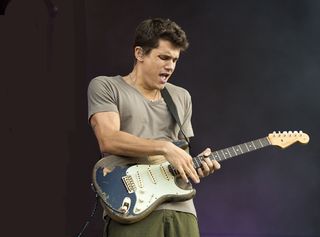
35 Fender Stratocaster stars: part 2
The Fender Stratocaster remains one of the most iconic designs in modern music.
MusicRadar kicked off its salute to 35 Fender Stratocaster stars: part 1 here. Here are another 17 players who've made the instrument their own.
Have we got everyone covered? Maybe we need a Part 3? Click through, digest, and let MusicRadar know...
Next page: John Mayer
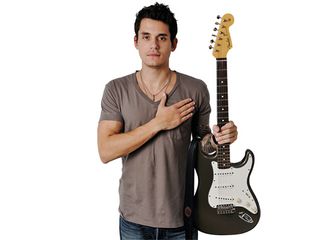
John Mayer
John Mayer can make life tough: he writes sensitive pop like Your Body Is A Wonderland, collects Grammys like baseball cards and dates the likes of Jennifer Aniston.
But Mayer is also a serious, Strat-loving blues hound, influenced by Eric Clapton (who‘s a fan), Stevie Ray Vaughan, Jimi Hendrix and Buddy Guy. Here he is, with Vaughan’s former guitar tech Rene Martinez checking out one of the first SRV ’Lenny’ reissues - now one of Mayer’s 200 guitars.
In 2005 he formed The John Mayer Trio with drummer Steve Jordan and bassist Pino Palladino. Their well-received album Try! put the world on notice that there was more to Mayer than radio fluff.
Mayer is pictured above with his limited-edition Signature Strat (all 500 were sold). His current Artist Series Strat features a three-tone sunburst body and three ’Big Dipper’ single-coils.
Next page: Bonnie Raitt
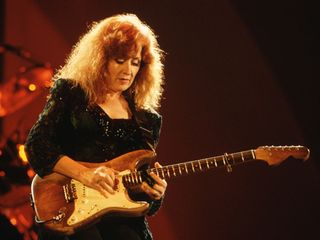
Bonnie Raitt
Raitt is a master – or should that be mistress? – of Strat slide. Her career has had numerous ups and downs but the uninitiated should head straight for 1998 album Fundamental.
Raitt was honoured with her own signature Strat in the ‘90s, boasting a narrower-than-normal neck, large ‘70s headstock and Seymour Duncan Texas Hot Strat pickups.
Next page: Ritchie Blackmore

Ritchie Blackmore
When your influences are Hank Marvin, Duane Eddy and JS Bach, you’re bound to write the world’s most famous guitar riff, Smoke On The Water.
Rising to fame in the early '70s in Deep Purple, Ritchie Blackmore became one of the first post-Hendrix guitar gods. His playing, almost exclusively on olympic white Strats of that era, was a blistering mix of bluesy pentatonic runs and ascending/descending arpeggios.
The notoriously combative musician - he’s quit Deep Purple twice, and his association with his own band, Rainbow, was no less stormy - started ’scalloping’ his guitar necks in the ’70s to increase his vibrato and emulate classical instruments. Yngwie Malmsteen followed suit a decade later.
Today, Blackmore is done with rock and now performs renaissance music with his wife, Candice Night, in the inventively named Blackmore’s Night.
Next page: Ry Cooder
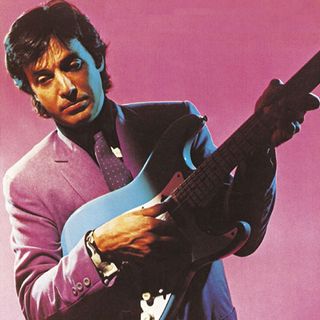
Ry Cooder
Synonymous with slide guitar, Cooder’s chilling bottleneck part on The Rolling Stones’ Sister Morphine found itself at number 47 in Guitarist magazine’s 2008 list of the 50 greatest guitar tones of all time.
Cooder’s gear is a weird and wonderful assortment of vintage pieces, often heavily modified. His blue ’67 Stratocaster is unusual for its bound rosewood neck, and was retrofitted with a Bigsby vibrato – which he believes increases high-end and harmonics – along with Guyatone and replica Bigsby eight-string steel guitar pickups.
Cooder’s #1 bottleneck guitar is another ‘60s Strat – a sunburst – with an Oahu lap steel pickup assembly and Tiesco neck pickup.
Didn’t anyone tell him those Strats are worth far more in all-original condition? Ahem…
Next page: Robert Cray
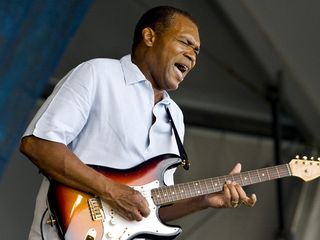
Robert Cray
Although sneered at by some misguided critics as ‘yuppie blues’, Robert Cray did much to revitalise the genre in the ‘80s.
Cray’s lissome voice perhaps resulted in his guitar skills being overlooked. But he can certainly play, sing, and weave new ways for blues - from breakthrough to 20 years on.
Cray’s own signature Fender Stratocaster debuted in 2005. Play it through a Fender Vibro-King or a Super Reverb amp to nail Cray’s sound. His vibrato technique may be harder to master.
Next page: Simon Neil

Simon Neil
Scottish trio Biffy Clyro’s blend of heavy pop hooks and skewed grungy riffs centres around Simon Neil’s Stratocaster. When not utilising the instrument’s naturally bright, percussive character for razor-sharp rhythm work, Neil is levelling buildings with the biggest dirty Strat sound you are likely to hear in a live environment.
Formerly favouring Mexican models with the neck pickup and controls removed, the Biffy mainman now plays Custom Shop relics, with a fiesta red ‘60s model his preferred live squeeze.
A young, exciting artist more-than deserving of a signature model? MusicRadar thinks so...
Next page: Yngwie Malmsteen
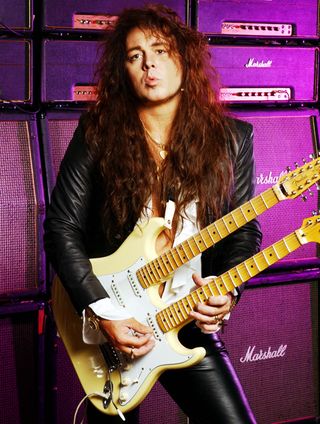
Yngwie Malmsteen
The neo-classical virtuoso may sometimes border on a caricature of his bad-self, but few guitarists have been so loyal to one model than Yngwie to the Stratocaster.
Even a short-lived 1986 Schecter signature model was decidedly one-dimensional in terms of its inspiration.
Yngwie signed an Artist Series contract with Fender in ‘87, which yielded the scalloped-fretboard, DiMarzio-loaded Yngwie Malmsteen Signature Stratocaster:
“That’s like a fine-tuned Ferrari”, explains Malmsteen, “That’s just sick. That’s just a monster of a guitar.” Nearly two decades later, Fender would lovingly recreate the original ‘Play Loud’ guitar based on the 1971 olympic white model that he’s played since his teenage years.
Next page: Pete Townshend
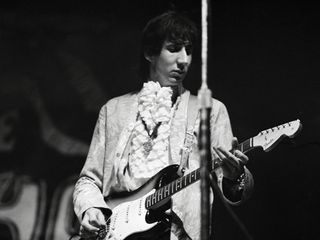
Pete Townshend
Rickenbackers, Gibson SGs and Les Pauls, Schecters; Pete Townshend has played and smashed to smithereens numerous electric guitars over the years. His flirtation with the Fender Stratocaster started 1966-68, but it wouldn’t become his number one electric choice until the first Who reunion tour in 1989.
In the years since, Townshend has used modified Eric Clapton Signature Stratocasters strung with .011-.052 gauge strings. The key difference between the stock Clapton models and Townshend’s is the addition of a Fishman Powerbridge used to blend in faux acoustic sounds.
Townshend’s tech Alan Rogan talks through his rig here.
Next page: Robin Trower
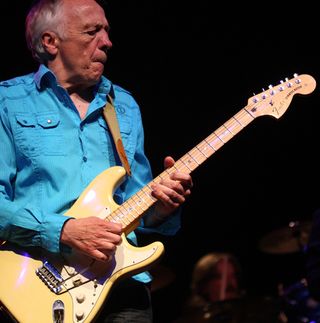
Robin Trower
The UK’s Robin Trower drew heavily on the spirit of Jimi Hendrix in the ‘70s, but his blues-rock wailing was surprisingly popular. Plugging into Marshall stacks, his Strat-plus-wah-plus-UniVibe setup sounded massive.
Trower is still doing it today. Watch him explain his signature Strat here.
Next page: The Edge
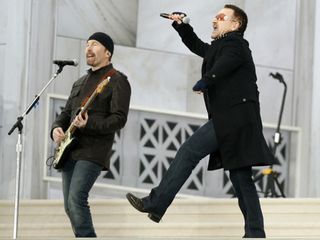
The Edge
Famous for his myriad, fantastical soundscapes, The Edge’s guitar collection is equally impressive.
Although he gained prominence for his use of the Gibson Explorer, The Edge has utilized a Stratocaster from U2’s earliest days. Some of his most notable Strat performances (heard on tracks such as Gloria, New Year’s Day and Bullet The Blue Sky) were played with a black 1973 model, appropriately called Blackie #1.
Edge has played numerous Strats, such as an Eric Clapton model seen here. In the above picture, he performs with Bono at a recent Obama pre-inaugural celebration with a 1962 sunburst model - and a multitude of FX, no doubt.
Next page: Eric Johnson
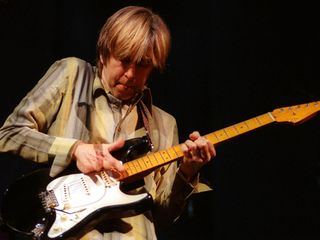
Eric Johnson
Johnson is the archetypal 'guitarist’s guitarist': a man who has never had a real hit but whose tone is praised by the likes of Carlos Santana, Eric Clapton, Billy Gibbons, Johnny Winter, Joe Satriani and Prince.
He plays Gibson ES-335s and Les Pauls among many other guitars, but it’s his Fender Strat tone that is most-lauded. Warning: you may need a rare Dumble amp and a huge array of effects to get anywhere near EJ’s tone.
His signature Stratocaster range debuted in 2005. Eric Johnson interview here.
Next page: Albert Hammond Jr
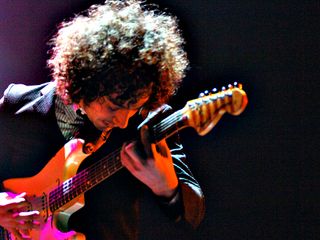
Albert Hammond Jr
Before Alex Turner, the newest kid on the indie block playing a white Strat worn way up high was one half of The Strokes’ lean, skinny-tied guitar assault.
More often than not, Hammond is the rock solid rhythm guy in The Strokes, but Last Nite alone proves that he’s more than capable of ripping out a great solo on his 1985 Japanese '70s reissue Strat strung with .012s.
While the whole band have tried their hand at side projects, Hammond’s debut solo LP Yours To Keep in 2006 is something of an underappreciated gem. Some in the MusicRadar office would argue it's the best thing that any of The Strokes have put their name to since Is This It.
Next page: Buddy Guy
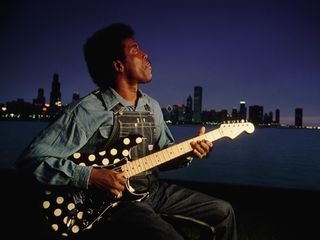
Buddy Guy
George ‘Buddy’ Guy has been playing Stratocasters from his 1960 breakthrough to his ‘90s renaissance and beyond. His own signature has a polka-dot finish because he promised his late mother that he’d buy her a polka-dot Cadillac when he was successful.
Mrs Guy is long gone, and Buddy’s not one for cars anyway. No, he loves guitars.
“You have to spend more time with that guitar than you do with your wife,” he says. “That's why I'm by myself now. My wife would tell me, ‘You're putting too much time into the guitar and ain't givin' me none.’ And I said: ‘You go, I'm keepin' my guitar.’”
Next page: David Byrne
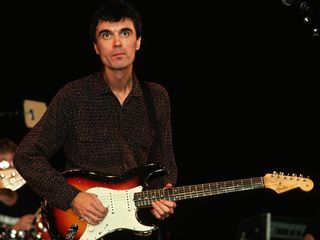
David Byrne
David Byrne may not be the first person you think of when Strat legends come to mind, but since the Talking Heads’ earliest days, when they would help sharpen New York’s late '70s new wave scene, he’s made his indelible musical mark with Fenders. First, it was a Duo Sonic; later a 1962 sunburst Stratocaster.
The minimalist, jagged guitar patterns that informed Talking Heads' first recordings bore the distinct sound of the Strat - the ‘62 especially, which became Byrne‘s road dog for many years.
Check out this live clip from 1980 of Take Me To The River, in which Byrne and the Heads are augmented by guitar maverick Adrian Belew.
Tent-show revival meetings this cathartic could only come from Stratocasters.
Next page: Tommy Bolin

Tommy Bolin
A Sioux City, Iowa native who filled the shoes of both Joe Walsh in The James Gang and Ritchie Blackmore in Deep Purple, Tommy Bolin’s status of ’Best Replacement Guitarist” is impressive enough. But he was an astonishingly gifted and forceful blues-rock player in his own right, who lit up every outfit he joined.
Bolin played a number of different guitars during his brief career, but his main instrument was a stock 1963 Stratocaster (treble dialed back, bass dialed full) which he powered through HiWatt tops and Sound City cabs. He described the combination as ‘hot.’
With his strong interest in progressive rock, jazz (he played on drummer Billy Cobham’s fusion masterpiece Spectrum) and reggae, there’s no telling where Bolin would have taken his music.
Tommy Bolin died of a drug overdose on 4 December 1976.
Next page: Robbie Robertson

Robbie Robertson
Robbie Robertson got the kind of rock ‘n’ roll education they don’t teach at GIT. He played lead guitar for Ronnie Hawkins at the age of 16 and, as a member of the Hawks, backed up Bob Dylan on his famed 1966 European tour.
Although he also uses Les Pauls and Telecasters, Robertson’s best guitar bits with The Band - gritty, sinewy rock-country licks stealthily snuck between organ and piano breaks - were played on Stratocasters.
Ironically, many fans came to know Robertson as he and The Band were packing it in. Here he is with his 1958 sunburst Strat (which he later had 'bronzed') going toe-to-toe with Eric Clapton.
Much speculation exists that Robertson installed a humbucker in his Strat. In truth, he simply moved the middle pickup to the bridge. (It helped facilitate his picking.)
Not bronzed is the new model he’s playing in the above photo with another EC. Nice guitar strap.
Next page: David Gilmour

David Gilmour
The black Fender Stratocaster belonging to Pink Floyd’s David Gilmour has become one of the most discussed in guitar nerd-dom. Has any other single Strat been deemed worthy of a whole book?
Gilmour’s black Strat has appeared on all key Floyd outings from Meddle to Live 8, yet he owns an even more-mythical model – the Fender Stratocaster with a neck-stamp of #0001.
The story of that white guitar (not the first Strat produced, but a ’54 for the most part) is a case of guitarcheology in itself.
Some Strat aficionados will happily pore over the details, most are happy with the sound Gilmour gets out of his Stratocasters. Just listen to Shine On You Crazy Diamond or Comfortably Numb.
Fender Stratocaster stars
Read 35 Fender Stratocaster stars part 1 here.
Has MusicRadar got the key players covered? If we've missed your favourites, say who (and why!) in the comments box below. Maybe part 3 will come soon?

MusicRadar is the number 1 website for music makers of all kinds, be they guitarists, drummers, keyboard players, djs or producers...
- GEAR: We help musicians find the best gear with top-ranking gear round-ups and high- quality, authoritative reviews by a wide team of highly experienced experts.
- TIPS: We also provide tuition, from bite-sized tips to advanced work-outs and guidance from recognised musicians and stars.
- STARS: We talk to musicians and stars about their creative processes, and the nuts and bolts of their gear and technique. We give fans an insight into the actual craft of music making that no other music website can.

“There’s three of us playing guitar in Foo Fighters… A lot of tone details can get lost, which is what drew me to the Cleaver – that P-90 cut”: Chris Shiflett on how he found his weapon of choice with his Fender Cleaver Telecaster Deluxe
PMT has gone bigger than ever with its early Black Friday sale, offering huge gear discounts up to 70% off

“There’s three of us playing guitar in Foo Fighters… A lot of tone details can get lost, which is what drew me to the Cleaver – that P-90 cut”: Chris Shiflett on how he found his weapon of choice with his Fender Cleaver Telecaster Deluxe
PMT has gone bigger than ever with its early Black Friday sale, offering huge gear discounts up to 70% off
Most Popular







